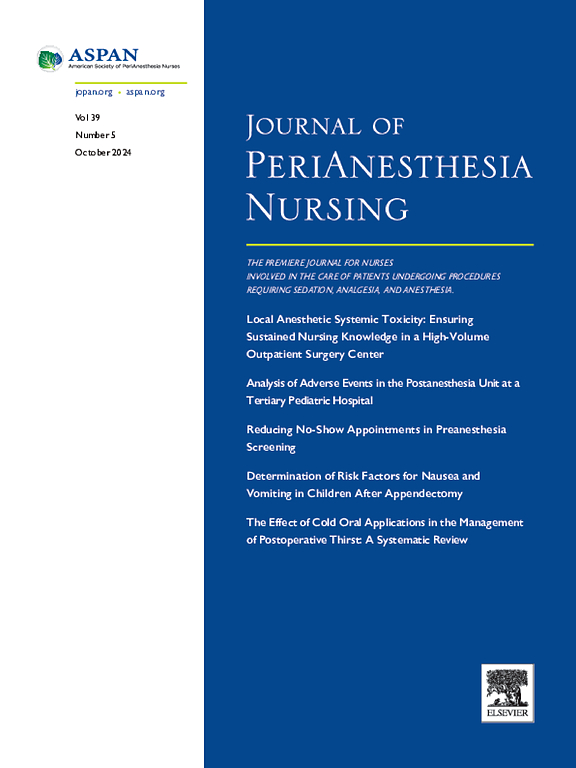The Relationship Between Preoperative Anxiety Level and Postoperative Pain Outcomes in Total Hip and Knee Replacement Surgery: A Cross-sectional Study
IF 1.6
4区 医学
Q2 NURSING
引用次数: 0
Abstract
Purpose
Preoperative anxiety is considered a common part of the surgerical experience and can be associated with serious postoperative side effects. This study aims to determine the relationship between preoperative anxiety level and postoperative pain outcomes in patients undergoing total hip replacement (THR) and total knee replacement (TKR).
Design
The study used a cross-sectional and correlational research method.
Methods
The study was conducted with a total of 104 participants, who underwent 17 THR and 87 TKR, at the Orthopedic Clinic of a state hospital in southern Turkey between June 2021 and June 2022. The State-Trait Anxiety Inventory (STAI) was used to determine preoperative anxiety level, and the Visual Analog Scale (VAS) and the Revised American Pain Society Patient Outcome Questionnaire (APS-POQ-R) were used to assess postoperative pain level.
Findings
The mean preoperative STAI-I and STAI-II scores of the participants who underwent THR and TKR were 53.95 ± 10.51 and 44.20 ± 10.55, respectively. There was a moderate positive correlation between STAI-I scores and VAS pain scores at preoperative and postoperative 6th, 12th, 24th, and 36th hours. There was a moderate positive correlation between STAI-I scores and affective subdimension scores, a moderate positive correlation with pain severity and sleep interference and activity interference, and a weak positive correlation between STAI-II scores and pain severity and sleep interference, activity interference and affective. The factors independently affecting the 6th-hour VAS pain score were determined as male gender, THR procedure, and increasing STAI score.
Conclusions
We found that high preoperative state anxiety was associated with early postoperative pain outcomes. State anxiety was associated with pain in the 6th postoperative hour. Considering the multidimensional nature of anxiety, further research is recommended to understand the anxiety domain in surgical patients.
全髋关节和膝关节置换手术中术前焦虑水平与术后疼痛结果之间的关系:横断面研究
目的:术前焦虑被认为是手术体验中常见的一部分,可能与严重的术后副作用有关。本研究旨在确定全髋关节置换术(THR)和全膝关节置换术(TKR)患者术前焦虑水平与术后疼痛结果之间的关系:研究采用横断面和相关性研究方法:研究对象为2021年6月至2022年6月期间在土耳其南部一家国立医院骨科门诊接受全髋关节置换术(THR)和全膝关节置换术(TKR)的17名患者和87名患者,共计104人。采用状态-特质焦虑量表(STAI)确定术前焦虑水平,采用视觉模拟量表(VAS)和修订版美国疼痛学会患者结果问卷(APS-POQ-R)评估术后疼痛水平:接受全膝关节置换术和全膝关节置换术的受试者术前平均 STAI-I 和 STAI-II 评分分别为(53.95 ± 10.51)和(44.20 ± 10.55)。在术前和术后第 6、12、24 和 36 小时,STAI-I 评分与 VAS 疼痛评分呈中度正相关。STAI-I 评分与情感亚维度评分呈中度正相关,与疼痛严重程度、睡眠干扰和活动干扰呈中度正相关,STAI-II 评分与疼痛严重程度、睡眠干扰、活动干扰和情感呈弱正相关。第 6 小时 VAS 疼痛评分的独立影响因素被确定为男性性别、THR 手术和 STAI 评分的增加:我们发现,术前高度的状态焦虑与术后早期疼痛结果有关。结论:我们发现,术前高度的状态焦虑与术后早期疼痛结果有关,状态焦虑与术后第 6 小时的疼痛有关。考虑到焦虑的多维性,建议进一步研究以了解手术患者的焦虑领域。
本文章由计算机程序翻译,如有差异,请以英文原文为准。
求助全文
约1分钟内获得全文
求助全文
来源期刊

Journal of Perianesthesia Nursing
NURSING-
CiteScore
2.20
自引率
17.60%
发文量
279
审稿时长
90 days
期刊介绍:
The Journal of PeriAnesthesia Nursing provides original, peer-reviewed research for a primary audience that includes nurses in perianesthesia settings, including ambulatory surgery, preadmission testing, postanesthesia care (Phases I and II), extended observation, and pain management. The Journal provides a forum for sharing professional knowledge and experience relating to management, ethics, legislation, research, and other aspects of perianesthesia nursing.
 求助内容:
求助内容: 应助结果提醒方式:
应助结果提醒方式:


